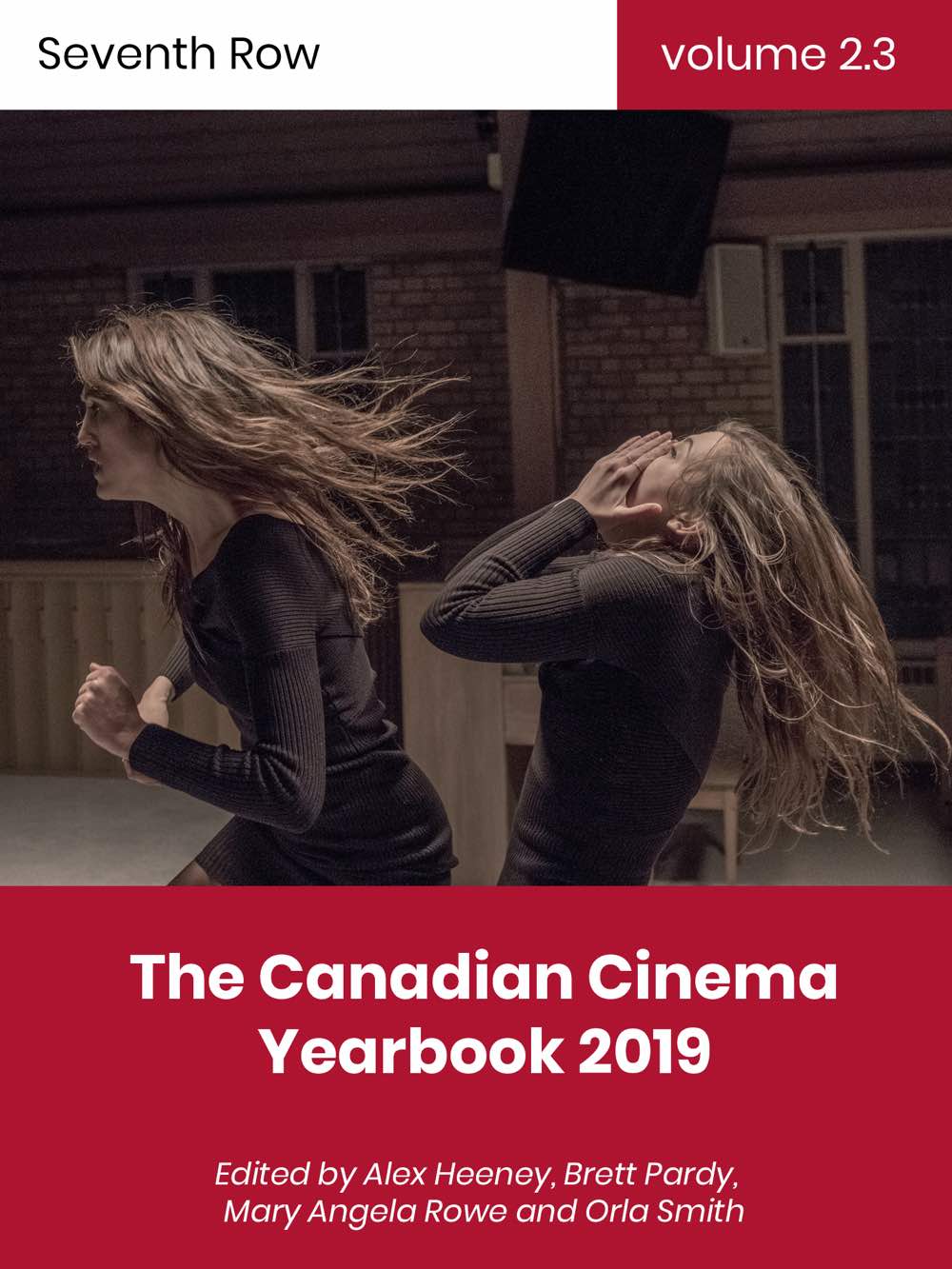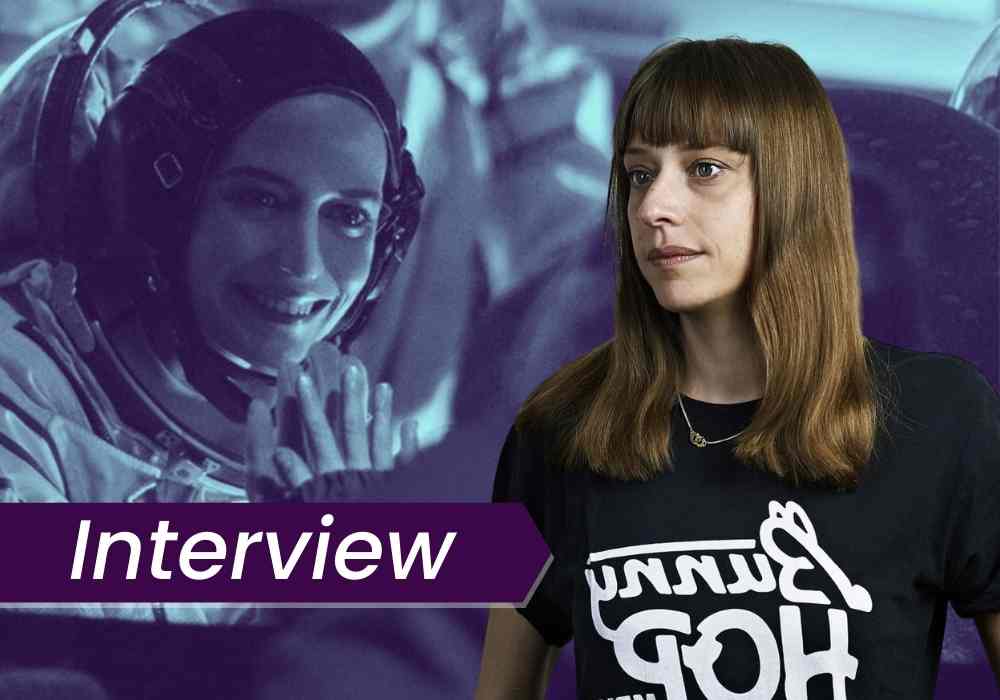In this career-spanning interview, Québécois writer-director Stéphane Lafleur reflects on the making of his new film Viking and how it fits into his body of work.
Read all of our TIFF 2022 coverage here.
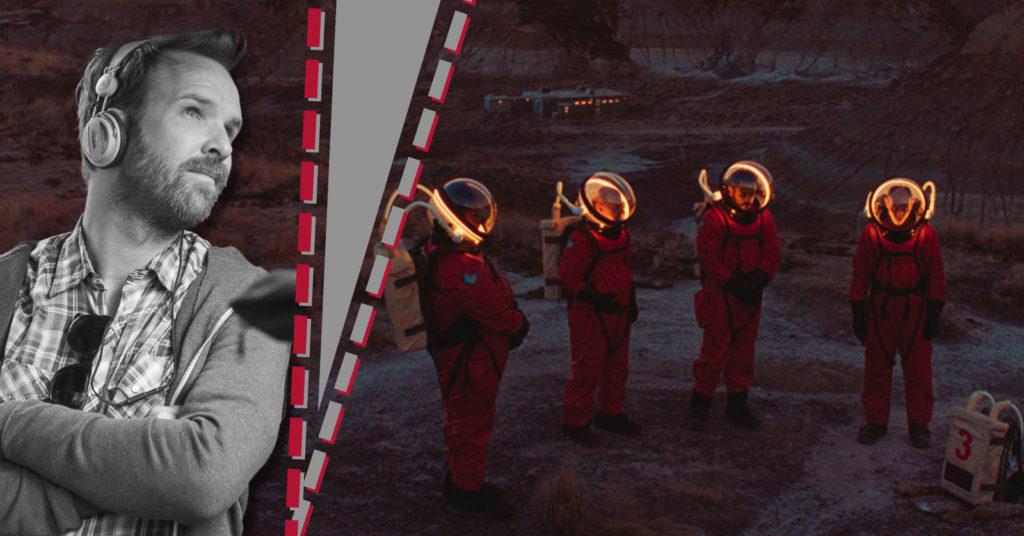
Discover one film you didn’t know you needed:
Not in the zeitgeist. Not pushed by streamers.
But still easy to find — and worth sitting with.
And a guide to help you do just that.

Don’t miss out on the best films on the fall film festival circuit
Join our FREE newsletter today to become a Seventh Row inside. You’ll get updates on how to see the best under-the-radar films, up-to-the-minute updates from our festival coverage, and tips on where to catch these near you.
There’s a great sequence in Apollo 13 where a part on the rocket breaks, so a team of engineers on the ground uses an identical part, plus all of the objects available to the astronauts in space, to troubleshoot a solution. The astronauts in space don’t have the time or energy to do this work since they’re losing oxygen by the minute, and it takes a team, not three guys barely surviving, to fix it.
Stéphane Lafleur’s fourth feature, Viking, is a feature-length rendition of this kind of troubleshooting that asks, what if we could do the same thing for interpersonal problems as we could do for a broken rocket part? After all, if there’s discord in the team up in space, they probably can’t solve any problems at all. As Lafleur put it, “It’s a reality show in space, but not in space. It’s just people doing, not boring stuff, but ordinary stuff, like being roommates.”
The plot of Stéphane Lafleur’s film Viking
Viking follows high school gym teacher David (Steve Laplante) who gets recruited to be a member of the B-Team on earth supporting the current mission to mars by the Viking Society. The Viking Society chooses him by running him through a series of personality tests to make sure he is an exact match for the person up in space whom he will be mirroring on the ground. As someone who has always dreamed of going to space, David is excited to accept the job that he believes will make him an instrumental part of the mission — even though it means evacuating his life for two years, during which he won’t even have contact with his wife.
The film’s surreal setting
Most of the film occurs in the bunker where David goes to live with his B Team in the middle of the desert. Here, they go by the names of their astronaut mirrors: David becomes John, a thirtysomething woman becomes Steven (Larissa Corriveau), and a middle-aged man (Denis Houle) becomes Liz. There, they will fight over petty things like whether David should be allowed an extra sugar cube in his coffee, whether or not it’s possible to clean oneself in a twenty-second shower with no water pressure, and what kind of a betrayal it is to steal someone’s only pen for a full month. At one point, they start a coup against power-hungry team leader Janet (Fabiola N. Aladin), who never seems to listen to what anyone says, but takes everything as seriously as David/John.
They get regular visits from the head of the Viking program, Christiane (Marie Brassard) to track their progress and get their feedback on what they’ve learned from the experience. She also provides them with absurd directives, like limitations on how many times they can masturbate per week based on what their shadow astronauts are doing. And they make daily excursions outdoors — in space suits, after waiting in an airlock for a few minutes — to do fake versions of the missions in space. Retrieving a probe becomes retrieving a silver garbage can.
A space movie in which nobody goes to space
Viking is the latest entry into the cinematic canon of great space movies in which nobody actually goes to space (e.g., Proxima). That’s partly a function of Quebec budget constraints for filmmaking. As Lafleur explained, “Doing films in Quebec, I know what budget I can have to make a movie. I wanted to find a good idea so that I could make something close to a real sci-fi movie, but assuming that I don’t have the budget to do it. Viking was the perfect idea.”
Here, Lafleur has found the perfect match between form and budget. The fact that budgetary constraints mean their space suits look almost real but not quite as nice, is in line with the whole premise of the film: it’s like going to space, without going to space. It also uses the heightened genre aspect of the film to shed light on ordinary experiences, like the futility of workplace interactions within a hierarchy and the challenges of living with roommates.
Ultimately, it’s a character drama in a space-like environment, and one with a lot of absurdist humour. The standout performance comes from Hamza Haq (one of Seventh Row’s Top 12 Emerging Actors at TIFF) who plays the most basic, but perhaps sweetest, bro on the team. We get to know less about him and his personal life than the other characters, but he regularly steals scenes. I didn’t know anyone could find that much comedic potential from clicking a pen repeatedly.
Lafleur’s cinema of drifters
Like Lafleur’s previous films, Viking is a movie about drifters, and as he put it “dream[s], disappointment, and deception.” But it’s almost a total reaction against his last film, Tu dors, Nicole, which was a languorous look at a teenager during her last summer before adulthood. Aesthetically, the films feel like opposites, too, though they are both shot by the great Québécois cinematographer Sara Mishara, who has worked on all of Lafleur’s films (and Maxime Giroux’s). Tu dors, Nicole was shot in black and white, in basements and backyards; Viking is shot in bright colours, especially reds and blues that pop, in a mix of confined spaces and the wide open landscape of the desert.
In Lafleur’s previous film, Tu dors, Nicole, Nicole has so much time on her hands and no idea what to do with it, so the film is deliberately paced and feels like a lazy summer. By contrast, Viking is about someone who knows what he wants, almost to his detriment. The film is thus also faster paced and more plot-driven. As Lafleur puts it, for David, joining the Viking project was “Une fausse bonne idée” (loosely translated as a “false good idea”). David has this obsession with going to space, and he can’t exorcise it and move on with his life without going through the Viking program. But the Viking program isn’t quite what it seems.
Paying homage to the great sci-fi films of the past
The aesthetic of Viking also pays homage to Lafleur’s favourite film, 2001: A Space Odyssey, which he calls the “Bible of sci-fi movies.” Every day, the crew gets a cue card print out summarising their shadow astronaut’s feelings of the day, from a machine that sits next to their bed and looks awfully like the computer Hal and his eye. The most private and personal conversations in the film happen in the airlock before the crew go outside. In 2001, that’s where Dave felt most safe from surveillance because he believed he wasn’t being watched even though Hal was doing so secretly.
In Viking, there are repeated references to how nobody can hear what’s going on in the airlock, and we have no reason to believe the conversations aren’t confidential. The bunker is also, hilariously, filled with computers and technology from the sixties. I didn’t think twice about it on the first watch. On the second watch, I thought, I guess that’s just because that’s what we think space technology looks like, given that’s when humans were going to space for the first time, and when films like 2001 were made.
A career-spanning interview with Lafleur, including his latest film Viking
This career-spanning interview with writer-director Stéphane Lafleur was conducted before the film’s world premiere at TIFF. Lafleur talks about the challenges of making the budget match the film’s ambition, finding the comedy and the pace, working with sound and score, and getting back into the swing of directing after an eight year fallow period. When Lafleur isn’t directing films, he edits films for other filmmakers (including the great Fireflies are Gone) so we discuss how his editing work has influenced his approach to filmmaking. Finally, we discuss some of the throughlines, aesthetically and thematically, across his career, as well as his ongoing collaborations with his heads of department, who have been working with him for fifteen years.
Our interview with Lafleur: the story behind Stéphane Lafleur’s film Viking
Seventh Row (7R): What’s the story behind Viking? What made you want to tell this story?
Stéphane Lafleur: It’s been a long process to get to Viking. The first spark of the movie was an exhibit I saw in New York by photographer Vincent Laforet. He did these really large format pictures of astronauts lost in the desert. I think the pictures were taken in the Utah desert. These pictures struck me. I kept thinking about them for several years.
I wanted to do a sci-fi movie after my last film, Tu dors, Nicole. These images kept coming back. Around 2014 or 2015, I heard about the Mars One project, where anyone could apply for a one-way trip to Mars. I was wondering who would apply for that kind of thing. At first, I wanted to tell the story of someone applying for this project. Then, the script became something else.
How research transformed Stéphane Lafleur’s film Viking
While I was researching my first idea, I saw a documentary about the Voyagers probes that we sent into the inner solar system to take pictures of all the planets. They were telling how keeping a replica of one of the probes helped them to solve problems during the mission. I thought, what if we apply this concept to humans? What happens? That was the premise of the actual script.
I wrote the first draft of the movie. The beginning was there, the ending was there, and the middle was still ongoing. I was stuck in front of all the possibilities that the script could take. It seemed infinite. So I asked my friend Eric K. Boulianne to co-write the film with me, to try to find an angle and keep it simple.
Stéphane Lafleur on why he wanted to make a sci-fi film
7R: What made you want to do a sci-fi film?
Stéphane Lafleur: It brings you back to when you were a kid and watching sci-fi movies. I always liked that type of film. Doing films in Quebec, I know what budget I can have to make a movie. I wanted to find a good idea so that I could make something close to a real sci-fi movie, but assuming that I don’t have the budget to do it. Viking was the perfect idea.
I didn’t want it to be just a cheap thing, and to be a parody of some kind. I wanted to play with the relationship we have with the United States, and with these movies, and me releasing a movie that is in direct competition with all the blockbusters coming from Hollywood with tons and tons of money. There’s something [meta] about that in the movie: [the characters in the film and the film itself] are trying to pretend to be something else.
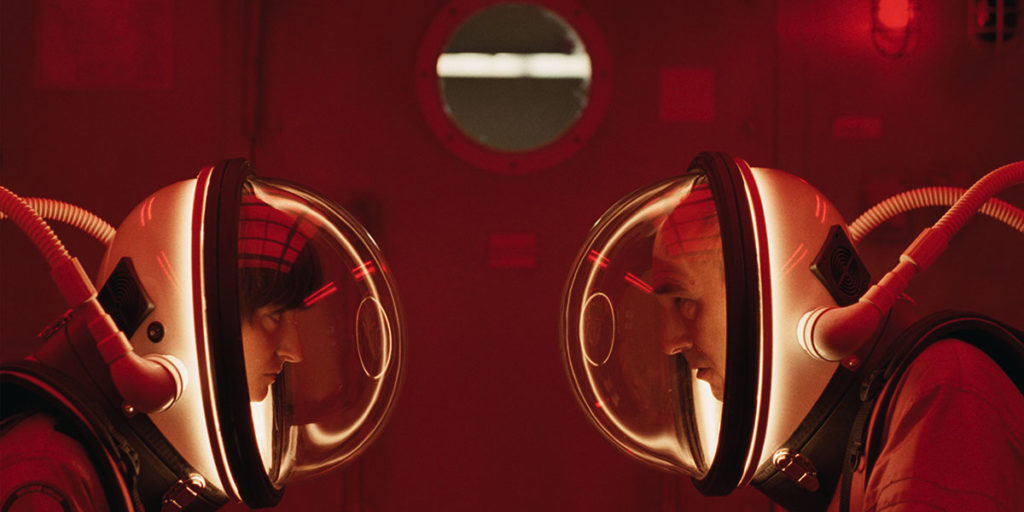
Inspirations for Viking and the realities of Canadian film funding
7R: Were you inspired by other sci-fi films? I saw some 2001: A Space Odyssey references in Viking, among other movies.
Stéphane Lafleur: For me, 2001 is the Bible of sci-fi movies. I think it’s honestly my favourite film. Visually, of course, it’s a stunning movie. I’m not trying to compare my film to 2001. It’s one of the films I watch one time a year. Each time, I learn something new about the film. Each time, it tells me something new. It’s a film that you grow with. When I watched it twenty years ago, it’s not the same thing as when I watched it two years ago.
Viking is my way to pay tribute to the people who inspired me, and try to do my own stuff at the same time. This film, Viking, is so absurd, in a way. At the same time, it’s almost ironic that when I started to write with Eric, it was at the beginning of [the] COVID [pandemic]. Some people read the script and thought we wrote it because it was a perfect script to shoot during COVID. There aren’t a lot of characters and there’s not a lot of proximity. But no, it was just a coincidence.
Lafleur’s Viking was an ambitious film that was perfect to shoot during COVID
7R: I’ve wondered whether the Canadian film industry was primed for the conditions of pandemic filmmaking because there’s already budgetary constraints. Even before COVID was an issue, most people in Canada were making movies with a small number of characters and all the things you’ve described.
Stéphane Lafleur: But still, you can imagine how ambitious that film, Viking, was compared to my old films in terms of needs and technical obstacles. It was still a really ambitious project. You need to find solutions with the budget you have. At the same time, that’s the fun part of it. The concept fit the budget. I didn’t want it to be a film that would pretend to be a really serious sci-fi movie but doesn’t have the means to do it. There’s also the comedy side of the film that helps [the audience to not notice] the lack of resources.

Don’t miss out on the best films on the fall film festival circuit
Join our FREE newsletter today to become a Seventh Row inside. You’ll get updates on how to see the best under-the-radar films, up-to-the-minute updates from our festival coverage, and tips on where to catch these near you.
Production design on Stéphane Lafleur’s film Viking
7R: Can you tell me about designing the aesthetic for the film Viking? You’ve worked with production designer André-Line Beauparlant on all of your films. I’ve seen Viking twice now. The first time, there were certain things I just didn’t even think about, like the computers all look like they’re from 1960.
Stéphane Lafleur: I don’t know if we got that right, but we didn’t want to do a parody movie of cheap sci-fi films of the ‘80s. That was not the intention. You develop your own little story about the background of the places where you’re shooting. For us, it was probably an old military bunker set in the desert that they were reusing. That justifies the old computers and the old machines and everything. At the same time, it’s about how we can make something that works with our story with the resources we have on board. That was probably one of the greatest challenges. And the suits.
Unexpected challenges of designing space suits
I really underestimated the work that we would have to put into creating the suits and helmets. When you’re looking for one helmet and one suit, that’s one thing. You can probably find one somewhere. When you want to design your own suits for five people, and they have to be identical, that’s another ballgame. You need to start from scratch. You try to find inspiration and build on that.
Then, the problems arise, like fog in the helmets. You want the suits to be comfortable for the actors. But they also have to look a certain way: finding the right colour, the right material. Where do you find the domes to do the helmets? Who do you call to make a space helmet for a film? You’d have to ask André-Line. She’s full of resources. But we did a lot of research. Then, you talk to someone who worked on a big American film in Montreal, and he knows someone that knows someone that knows someone. And you end up in a garage of someone who knows how to do it, has certain expertise, and someone with a 3D printer.
I had to let go at some point. It was a full-time task just to do the helmets and everything. But it was fun, because we were all doing this for the first time. It was really exciting. Visually, each step was exciting.
The importance of prep on Stéphane Lafleur films including Viking
We had a lot of prep. On each film I’ve worked with André-Line on, there’s long pre-production before the shooting. André-Line, the DP [Sara Mishara], and I just talk about the film, watch images, find inspiration here and there, and try to build a mood board for the film. Then, the decisions you make while preparing the film become clearer and easier.
Because of COVID, we had to postpone the shooting. I think it was a good thing because it gave us and the production designer more time to talk and dream about the film.
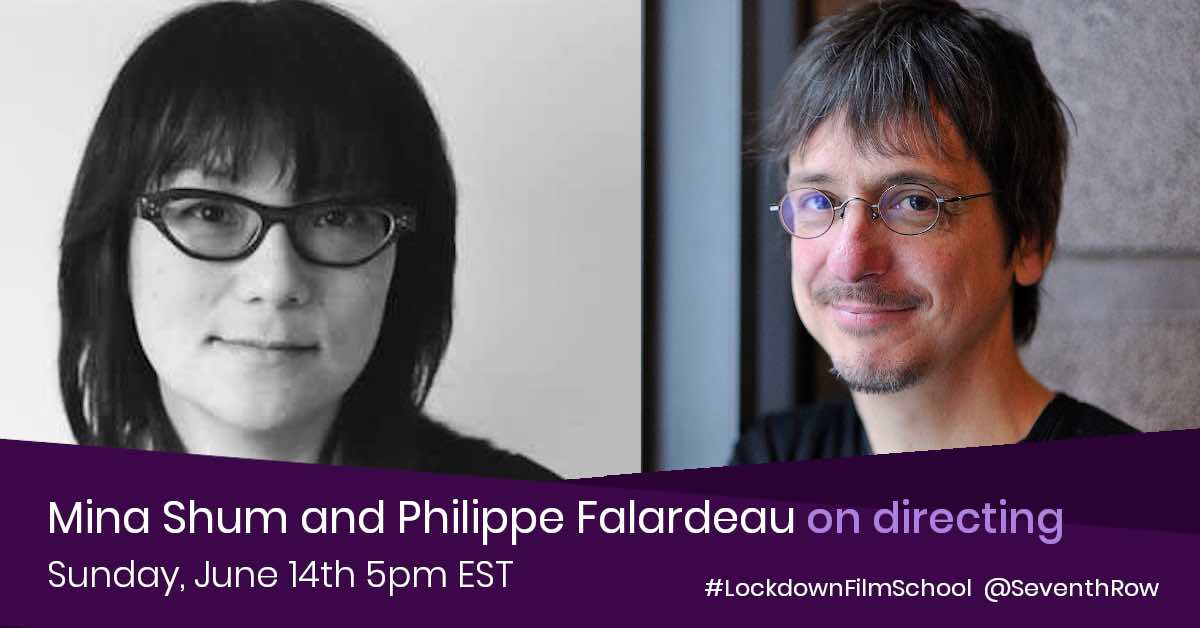
Philippe Falardeau has also worked with Viking DP Sara Mishara and actor Hamza Haq
He discusses working with both in our masterclass featuring Falardeau and Mina Shum.
Working with cinematographer Sara Mishara
7R: Can you tell me about your collaboration with cinematographer Sara Mishara? You’ve worked with her on all of your films. I think she’s become one of the great Canadian cinematographers.
Stéphane Lafleur: With Sara Mishara, we started talking about the film a long time ago. My collaborators are good friends of mine anyway. When I start working on a new film project, I usually tell them the idea, even though we will probably shoot in five years. But then they can start collecting ideas, collecting images. While working on other stuff, they can think [about the film]. Maybe they will stumble upon something that is interesting for our film.
Sara and I started talking about this film a long time ago and watching a lot of sci fi movies. We decided what we wanted to do and what we didn’t want to do.
Storyboarding and setting the pace
I usually storyboard all my films before shooting. Then, Sara and I work together, placing the storyboard and discussing the storyboard, mostly. When we get on the set, we know exactly what we’re doing. We know what we’re here for. It’s a lot of prep to save time on the set.
There’s a pace to set, too. I wanted this film to go a little bit faster. I wrote my previous script really instinctively, not thinking too much about the drama and different steps in the film. Writing this script with Eric meant that he brought that sense of faster pacing to the script. I learned a lot from him. Our two styles helped us create a poetic side in the film. It also created a storytelling side [of explicit plot, action, and motivation] that is maybe more assumed than in my previous work [which is looser and less plot-focused].
How Lafleur’s films look so different from each other
7R: Your films together look so different.
Stéphane Lafleur: After doing Tu dors, Nicole in black and white, it was fun to go all out in colour [with Viking]. The red came early in the process. We decided to put a lot of different colours in the same images. In the films before Tu dors Nicole, like Continental, un film sans fusil (2007), we played a lot with earth tones, like browns and beiges and greens.
For Viking, we wanted red and blue, the basic colours. Once we decided that the suits would be red, the whole palette became clear. The other suits were blue. You build your own stories, trying to find out when this bunker was made. It was probably in the ‘60s, so we thought about what was the colour palette in these years and stuff. One thing leads to something else. You build your own little world for the bunker. We knew that the outside would be yellowish and desert and dry. The interiors were designed to be reclusive, with artificial lights, and not a lot of windows. We wanted it to feel like we’re trapped with them in a way, to try to feel a little bit how they feel.
Unchanging elements of Lafleur’s aesthetic
But there are a lot of constants, too [in how we shoot together]. I’m really conservative in my way of shooting. It’s always on a tripod. She’s always trying to push me, in some ways, to try new things on each film. Slowly, slowly, I’m moving with the new stuff and new ideas. We shot in 35mm [for the film Viking]. We wanted to shoot in 35mm since the beginning, like the other sci-fi films we love. We’re also big fans of American films of the ‘70s: the texture and everything. That was the look we were looking for a little bit, especially for the desert shots and the zooms. We took a lot of inspiration from these great films.
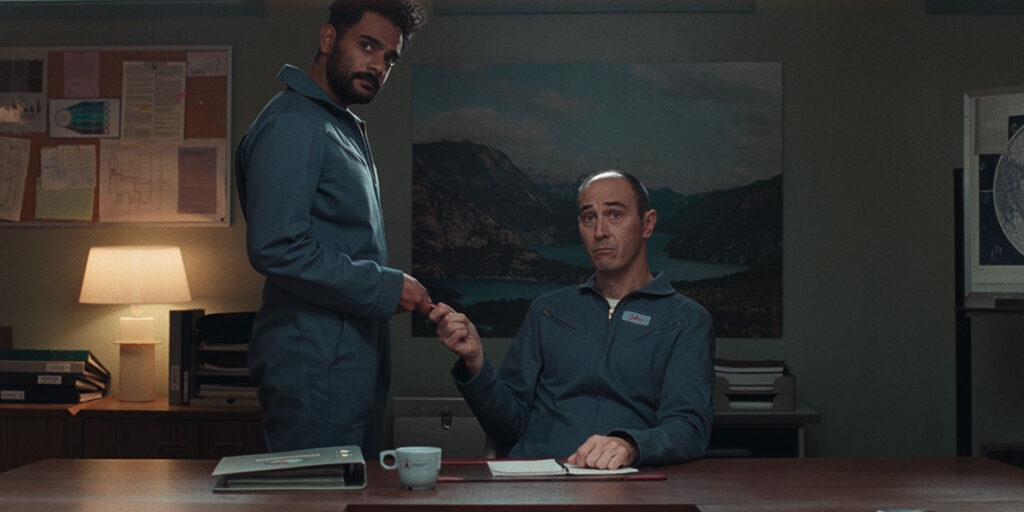
Stéphane Lafleur’s cinema of wasting time
7R: Tu dors, Nicole is about somebody with time on her hands to waste. Your new film Viking is about people who think that this thing they’re doing is so urgent, but then, we find out that they’re wasting their time. The tedious workplace dynamics in Viking also reminded me a bit of Continental, un film sans fusil.
Stéphane Lafleur: Exactly. I think it’s a recurring theme [in my work] with different angles on the same thing. I don’t know why though.
[For Viking,] I wanted a character that knew what he wanted, even though it ends up being maybe… I don’t know if we can say a mistake. In French, we say, a false good idea — “Une fausse bonne idée.” I wanted to have a character who was different from Nicole. Nicole didn’t know what she wanted.
Lafleur’s first character who knows what he wants in the film Viking
I liked the idea of a character in Viking that is passionate about something. He wants to get to the bottom of it, so he dives in. Then, he realises that it’s not what he thought. We kept saying, dream, disappointment, and deception. Those were the key words of the prep of the film. You think of the uniform of the astronaut, but [what our characters wear is] not quite the real thing. It’s a little bit cheaper.
When I was pitching the film Viking, I was saying, it’s a reality show in space, but not in space. It’s just people doing, not boring stuff, but ordinary stuff, like being roommates.

Don’t miss out on the best films on the fall film festival circuit
Join our FREE newsletter today to become a Seventh Row inside. You’ll get updates on how to see the best under-the-radar films, up-to-the-minute updates from our festival coverage, and tips on where to catch these near you.
How Sara Mishara and Stéphane Lafleur decide where to put the camera
7R: I imagine one of the challenges is figuring out where to put the camera in relation to the actors, because we have to care about them, but we also have to be able to laugh at them.
Stéphane Lafleur: It’s funny that you talked about Continental, un film sans fusil because in a lot of that film, the camera was not moving. It was only one shot per scene, mostly. I wanted it to be like a surveillance camera in a way, where the audience is just invited into a room to observe some people doing mostly nothing.
For this film, Viking, the new thing for me was filming so many people at the same time all the time. Where do you put the camera? Who do you want to see at which moment? Of course, David is the lead role. We were living the mission or the trip with him, through his eyes. But you want to watch the others, too. Sometimes, it was difficult, because the place [we were shooting in] was not that big. We’re always coming back to the same places, which was partly deliberate. Every day feels the same, and is in the same space.
Filming both wide landscapes and on a confined set
7R: How did you and DP Sara Mishara think about shooting in that confined set. How do you make that visually interesting? On the other hand, you have the big, vast desert outside.
Stéphane Lafleur: We started the shooting with the vast landscape, and it made the whole thing really, really exciting when we started receiving the rushes of the first days. Especially at the beginning of the movie, I tried to share the dailies with the team. At night, we watched the dailies so everyone could see what they were working on. Some people are really far away from the monitor, and they cannot really see [what we’ve shot]. They see the sets, and they see the costumes, but they don’t see what’s happening. Seeing the dailies makes it clear for everyone what project you’re working on right now. People were excited about these landscape shots.
Going inside was a big challenge. You spend three days or four days in the bedroom, and it’s really, really tiny. There was something that I liked about the repetition of some shots and the fact that it’s always the same day starting again, in a way. But at times, you don’t want it to [look so similar]. You want to keep it interesting. That was the challenge. Sometimes, we were scratching our heads and thinking, what can we do today to make this thing more exciting? At some point, it seems you’ve seen all the angles of the room, and you don’t want to film it.
The surreality of Stéphane Lafleur’s film Viking
7R: There is this eerie surreality to the film. You have these scenes that are just the cameras on sticks, and there’s two people talking, shot-reverse-shot. There’s something about the distance we’re at from the characters, or maybe it’s also the sound, but it just feels so bizarre. It’s in the script, too, of course, like when Christiane, the woman running Viking, asks David how many times he’s masturbated. Obviously, that’s going to be a funny and awkward scene. But even before that, you’re kind of uncomfortable.
Stéphane Lafleur: I wanted that room [where David would talk to the people in charge of Viking] to be like a small confessional. It should have the feeling of being in a church and being really close to the other person where you can confide your personal thoughts to Christiane. That’s also about the limits of the budget. We have money to build a certain number of rooms, but we were trying to cut down the number of rooms. I think the film could have maybe taken one or two more just to break that feeling of being always in the same place. At the same time, that’s what the characters are living, so that’s the compromise, I guess.

Don’t miss out on the best films on the fall film festival circuit
Join our FREE newsletter today to become a Seventh Row inside. You’ll get updates on how to see the best under-the-radar films, up-to-the-minute updates from our festival coverage, and tips on where to catch these near you.
Directing ensemble scenes
7R: I know most directors say that the hardest thing to do is to shoot a scene with lots of characters.
Stéphane Lafleur: Especially when you want to catch the reactions of these characters. It implies that you shoot everyone, then you decide in the cutting room, what do you keep? Where is the camera? Who are we watching at this moment?
When we had a lot of characters, we shot a lot of coverage. Otherwise, when it was only David, I was always trying to choose a single shot and just keep it simple. You have to follow the script. I would prefer sometimes to do fewer shots for a scene, but then we’re missing something that seems important to me.
How working as an editor has shaped Stéphane Lafleur’s directing
7R: When you’re not directing, you work as an editor. How has that shaped your approach to directing?
Stéphane Lafleur: The film is made in your head while you’re doing it, before doing it. I think we did that even more on this film. Sometimes, actors have questions on the set, and I can answer by saying, “No, no, don’t worry, because we’re cutting there at this moment.”
I don’t direct anything else except my own films [that I’ve written], which makes me someone that doesn’t shoot a lot. Tu dors, Nicole was eight or nine years ago. I’m not practising a lot so it’s new all the time. You have to really… not relearn, but get accustomed to the shooting. The first days are like, “Okay, we’re back, let’s do this!”
Having a plan
While preparing the storyboard, I have a really good idea of when I will cut from one shot to the other and what I’m trying to cover with each shot. The exception in this film, Viking, were the long shots of the dinner scenes, where there’s a lot of people talking. I knew that the rhythm of that would be found in the cutting room.
Otherwise, what you see in the film is mostly what we shot. I knew that I didn’t need five shots for the edit. I only needed one or two, and could work with that. Sometimes, I will try the same shot with two different lenses just to have an option of: do I want to be that close, or just a little bit?
It’s tough to judge when you’re shooting. You’ve got this small screen, like an iPad. The wide shot looks wide on the iPad. But then, you watch it on a bigger screen, and we’re so close. It’s not far enough. I’m always surprised by the disconnect between the perception you have shooting, and then what you see on the big screen. It seems you always have to think wider. You can always go a little bit further, and it will be fine. I’m getting better at it.
Working with actors
7R: What is your process for working with actors?
Stéphane Lafleur: It depends on the film and the content of the film. In this case, what the actors had to do was not simple, but it was pretty straightforward. I like to do a reading of the script with everyone, so the information is the same for everybody. Everybody’s listening to me telling them things about the script. I just want to make sure that we’re all going to shoot the same film, so the reading is really important. But we didn’t do any rehearsal. It was more talking about some specific scenes, and getting to know each other.
I like to get to know the actors before we’re shooting and how they react to the things I’m saying. Every actor is different, so you want to find the right language for each actor. I was working with a lot of them for the first time. I’ve seen Steve Laplante, who plays David, in theatre for the past twenty years, but we never worked together. I knew he was a clever actor. He read the script, and he knew what to do. I hadn’t worked with most of the other actors before — Fabiola N. Aladin as Janet, Larissa Corriveau as Steven, and Hamza Haq as Gary. I had worked with Denis Houle, who plays Liz, two times before.
This project was so much fun to do from day one. The shooting had, of course, a lot of challenges, but it was so much fun with so many great people. There’s not a lot of opportunities to do these kinds of sci-fi-ish movies around here [in Quebec and Canada]. So everyone was excited to collaborate on this project.
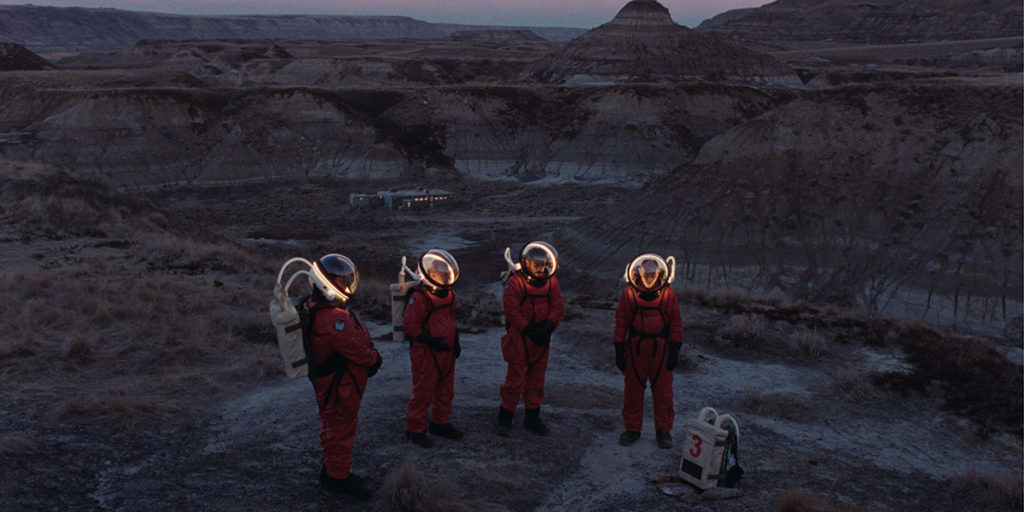
Stéphane Lafleur on editing the film Viking with Sofia Leblond
7R: What was the editing process for the film Viking like with Sofia Leblond?
Stéphane Lafleur: Sofia is a good friend. We’ve been working together for the past twenty-five years now. I think the storyline was pretty clear in the script, so the editing was more about rhythm. How long do we stay where, and when? The storyline was pretty clear.
The beginning was a bigger challenge. I wanted it to be mysterious, but efficient [in its storytelling] at the same time. I wanted David to leave his home for the Viking project quickly in the film. But at the same time, we had to show what he was leaving.
We didn’t start by editing the beginning of the movie. We spent a lot of time editing all the rest of the movie, and then we came back to editing the beginning of the movie. That let us find the base of the film that would lead us to [figure out how to depict] the departure.
The sound design behind the film Viking
7R: How did you approach the sound design for the film Viking?
Stéphane Lafleur: I love sound design. There’s a lot of sound indications in my scripts.
I wanted the setting of the film [the bunker they live in] to seem like a realistic environment. The bunker is a bunker; it’s not a space station. So we tried to build it that way. I like these industrial environments with [the sound of] ventilation and machines. It’s just so fun to build them and to edit. I knew I wanted to hear the old tubes and everything behind the helmets.You hear the chairs squeak during the meetings. I like all these details that give life to the objects but also to the people.
We actually do a lot of sound design during the editing process. For all my films, we make a list of sounds that we would like to have. Then, the sound designer gives us a bank of sounds. We do a first draft of sound design [in the edit]. I think it’s important for people who give you feedback on the film to see and hear it as closely as possible to what you want to achieve in the end. Then, the comments will be more appropriate for what the film actually is.
I think it’s hard for people to imagine the next steps of a movie if you’re not doing it in life. It’s hard to understand that there will be colour correction, sound mixing, sound design, and foley. Foley is one of the most magical moments of filmmaking. When the foley comes in, everything takes life. Suddenly, there’s another engine added to the film. But a lot of people don’t know about that.
The music in Viking
7R: What’s the story behind the final needle drop at the end, which I thought was hilarious. It’s so perfect for the film, and the French version of that song is quite a funny translation. Like everything about the Viking project, it’s close to the real thing — it shares the tune and the vibes — but still isn’t quite right.
Stéphane Lafleur: I was glad I stumbled onto the song. There was another song that was in the script, I won’t tell you which one. But then I saw another recent film that used this song. I was like, damn, I had the perfect song for my ending. Once I decided to change it, I stumbled into that song [we have in the movie]. I wanted something really light and to make a big break with all the rest of the movie.
Developing the score
7R: How did you develop the score?
Stéphane Lafleur: This is the film where I had the biggest original score of all my films. In Tu dors, Nicole, there was some organ mood music, but it was music that already existed. And then, they added some small parts to complete it. So it was easy to use the score while we were working on the edit of the film.
For this film, Viking, I asked them [Organ Mood, Mathieu Charbonneau, Christophe Ledoux-Lamarche] to do an original score from scratch. They’re also good friends of mine. I had this idea of the saxophone in space. I wanted [the music of this space movie] to be jazz this time. That was my first idea. That’s how they started the process. They did a lot of jamming. It was a lot of hit and miss before we found the right path. It was fun.
They also did the music that Hamza [Haq] dances to at the party. They did a lot of little stuff in there that we almost don’t notice but that is all coming from the same composers.
Stéphane Lafleur reflects on his cinematic preoccupations Viking
7R: Now that you’ve made Viking, do you feel like you want to move in a totally different direction? Or is that an idea for five years from now?
Stéphane Lafleur: We started talking about the next one. I don’t know what it will be yet. I don’t know, another adventure. It’s fun, too.
I feel there’s a continuity in the work I’m doing. I’m not trying to reinvent myself totally from film to film. There are scenes in the film Viking that we were laughing about because this is this scene in Tu dors Nicole, this is this scene in En terrains inconnus. It seems you’re always redoing the same stuff with different characters, with different stories. I can see the themes and the situations that are coming back from film to film. Why, again, I have no idea. I guess it’s in me. I have to put these things out somehow. But I’m not sure yet where I’m going. I don’t think it will be in space though.

Don’t miss out on the best films on the fall film festival circuit
Join our FREE newsletter today to become a Seventh Row inside. You’ll get updates on how to see the best under-the-radar films, up-to-the-minute updates from our festival coverage, and tips on where to catch these near you.
7R: What are the themes that you feel you keep returning to?
Stéphane Lafleur: This idea of juggling with what you want to do with the time you’ve got, with your life. I think it’s a theme that comes back from film to film. They’re about people that are wondering if they are in a good spot. In a way, this character in Viking, David, was different from my previous work, because for the first time, there’s someone who really knows what he wants. But then, there’s all this disappointment on the way. It was a new approach for a similar theme.
On finding themes
7R: I was thinking about what I think are some of the throughlines, and there’s almost this Waiting for Godot element to your films.
Stéphane Lafleur: I never start a project with themes. The themes come further along the way. I start with images I want to see. I start with a feeling, but I have no idea, at the beginning, what it’s about.
Usually, after the first or second draft, there are some themes that come to the surface, and then you start throwing away some ideas that don’t go in that direction. It’s such a mysterious process. It feels like it’s something that has to get out of you at this moment in your life. You can’t fight against it.
At some point, you’re obsessed with certain elements. You have to do the film to get rid of these ideas. And that’s exactly the motivation of David in the film. He has to do it, to get to the bottom of this and get rid of this [obsession with going to space]. Some people thought that the film had a negative ending. I thought, No, it’s great! He is free. He has freed his mind, so he can move on to another project, another thing.

Don’t miss out on the best films on the fall film festival circuit
Join our FREE newsletter today to become a Seventh Row inside. You’ll get updates on how to see the best under-the-radar films, up-to-the-minute updates from our festival coverage, and tips on where to catch these near you.
Working in the Quebec film industry
7R: As an editor, you’ve worked with a lot of major filmmakers in Quebec, like Sébastian Pilote. And you share collaborators on your films with many other major auteurs in Quebec, like Sara Mishara, who also works with Maxime Giroux. Is that a fruitful community for inspiration and sharing ideas?
Stéphane Lafleur: It depends. With some people, yes, and with some people, there’s no connection. But it’s a really friendly community. I’m always glad of the success and the achievement of others. I think we all benefit from the success of others. When there’s a few films coming out of Quebec that are good and well received, it shines a light on the other films as well, maybe. It’s true for any place in the world. It’s always good when there’s a lot of good films made in a certain time and place.
I feel lucky to do films really. The older I get, the more lucky I feel. Unfortunately it’s getting harder and harder [to make films]. To be honest, while shooting Viking, I was thinking to myself, maybe it’s the last one. You never know, so enjoy it. I try to enjoy the ride.
Stéphane Lafleur’s film Viking had its world premiere at the 2022 Toronto International Film Festival, where we reviewed it as one of the Best Acquisition Titles at the festival. It is still seeking North American distribution.
Discover more great Canadian films like Stéphane Lafleur’s Viking
2019 was one of the best for Canadian cinema in history. Discover these great films through conversations with the filmmakers, guided by the Seventh Row editors in our inaugural annual book, The 2019 Canadian Cinema Yearbook.
The book features films edited by Stéphane Lafleur (The Fireflies Are Gone) or made by his collaborators (e.g. Sara Mishara was DP on The Great Darkened Days).
Discover more great space films, in which the protagonists are mostly on Earth, like Stéphane Lafleur’s film Viking

Become a Seventh Row insider
Be the first to know about the most exciting emerging actors and the best new films, well before other outlets dedicate space to them, if they even do.
